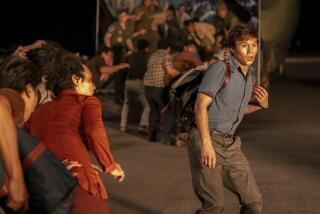Filmmaker Called Up for Patriotic Mission : Military: The result is a U.S. training movie on how to survive as a hostage. But don’t look for it in the theaters.
You won’t find Myrl Schreibman’s name in the credits of his last picture.
The movie doesn’t have credits.
And the movie isn’t coming soon to local theaters.
Schreibman doesn’t actually know where it is being shown, although he hopes it is being seen by U.S. military personnel and others involved in the war in the Gulf.
Schreibman’s film is no ordinary picture, obviously. It is a training film, made last summer for the Department of Defense, with the less than zippy title, “Peacetime Detention/Hostage Survival: It Can Happen to You.”
“I don’t pick the titles,” Schreibman said. “I just make the movies.”
Like Frank Capra and other makers of military and propaganda films before him, Schreibman was asked to bring the arts of Hollywood to bear on a patriotic mission. The Department of Defense handed him a script that shows military personnel being held captive in three peacetime situations. “The challenge for me as a director and producer was to make dramatic sense of it,” says Schreibman, an adjunct assistant professor in UCLA’s department of film and television.
Security on the film was tighter than on a Woody Allen shoot. The movie is designed to help military captives stay alive and resist the efforts of their peacetime captors to gather information, Schreibman says. The movie presents three situations, based on actual incidents: a Green Beret traveling in civilian clothes on a plane that is skyjacked by Middle Eastern terrorists, a naval attache kidnaped by Latin American guerrillas, and a flight crew that has to ditch over an unfriendly country. A voice-over provides the military’s interpretation of the action.
Because the flight crew segment contains classified information, Schreibman and his crew of nine, including seven UCLA students, had to get security clearance. The material was so confidential that Schreibman was not allowed to have a copy of the finished film.
“My expertise is to get high picture value for low money,” says Schreibman, 45, of Van Nuys, a UCLA graduate who has worked in movies, theater and TV.
Schreibman stretched a small budget--”way under $100,000”--for maximum effect. A neighborhood in Redlands with Spanish-style architecture served as the Latin American city where the fictional naval attache was kidnaped. The jungle hut in which the attache was held was built on a sound stage at Norton Air Force Base. “We brought a little bit of Hollywood to San Bernardino,” Schreibman says. A smoke machine gave the interior of the hut “a seedy quality.” He also smoked up the mock-up of a DC-9 in Pacoima, used for the skyjacking sequence, to suggest worsening conditions inside the plane as the passengers waited to be released.
A filmmaker is a filmmaker even when he is working with a government script and a technical adviser in an Air Force uniform at his side. Schreibman knew the movie “couldn’t be like ‘Scarface,’ ” if only because the military insisted on a non-Hollywood verisimilitude. But Schreibman admits he screened “The Bridge on the River Kwai” several times in preparation for the jungle captivity scenes.
Necessity was frequently the mother of cinematic invention. There was not enough money to rig squibs--capsules of fake blood used to simulate bleeding wounds. So instead of showing the gunning down of the attache’s chauffeur, Schreibman showed the aftermath of the man’s murder, using makeup to suggest a fatal shot through the forehead. The military singled the scene out for its effectiveness, he says.
Schreibman says the film was an education for him. When U.S. military men taken by the Iraqis were shown on TV recently, Schreibman noticed immediately that they did not have identifying patches on their uniforms. Even in peacetime, military people who are captured are advised to take off such identifying marks, he says. Watching the captives on TV, he also recalled that his film advises military personnel to allow themselves to be photographed by their captors “so people on the outside know they’re OK.”
“Does that have any relevance to seeing our hostages on television? Maybe,” he comments.
Schreibman is currently considering a project in Malta. He says of flying there, “I keep running the segment on the airliner over and over in my head.”
Making the film taught him some of the standard tricks of the terrorist’s trade. They often move passengers around in a skyjacked plane so that women are in the aisle seats, forcing male passengers attempting acts of resistance to clamber over the women. He also recalls what happens in the movie to a passenger, called “The Loudmouth” in the script, who is always screaming at the terrorists that they can’t do this, that he is a U.S. citizen and has friends in high places.
“Eventually the terrorists shoot him in front of the other passengers to set an example.”
Schreibman says he is very proud of the movie, just as he is of an earlier training film on explosives handling (both were made through TGS Technology of San Bernardino).
“Whether I believe in the war or don’t believe in the war isn’t the issue for me,” he says. “Human lives are involved, and I know the film has elements in it that can help save lives, whether in peacetime or war.”
More to Read
Only good movies
Get the Indie Focus newsletter, Mark Olsen's weekly guide to the world of cinema.
You may occasionally receive promotional content from the Los Angeles Times.










